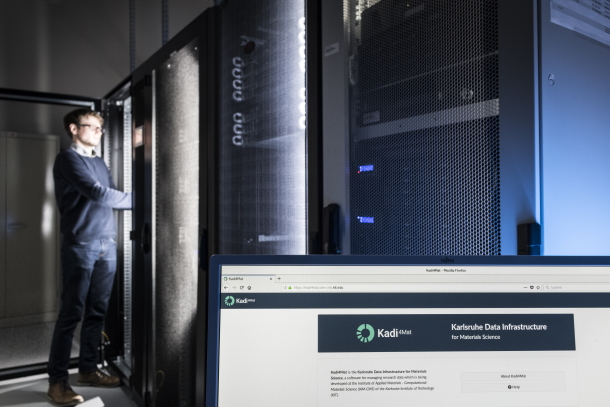With the Kadi4Mat platform, the Institute for Applied Materials at KIT has created a way to combine access, management and exchange of large amounts of research data with their analysis, visualization and transformation.
There are countless research facilities worldwide where experiments and simulations generate both, many and large research data sets. This data contains information that provides answers to current research questions. The increasing amount of research data and its complex interrelationships require deliberate and organized handling to enable its accessibility, reproducibility and use. Loss of information during data processing, for example due to the change of doctoral generations, are avoided by a well-structured research data management.
The Karlsruhe Data Infrastructure for Materials Science, or Kadi4Mat, was created to provide a solution for processing and organizing research data for small and large research associations and as part of the National Research Data Infrastructure funded by the federal and state governments. Kadi4Mat was brought up to cover the entire research workflow in a structured manner, from data creation, through the connection of devices for experimenters and simulation environments, to data publication. The focus of the infrastructure is on data management as well as the application of machine learning. "Storing, sharing and making accessible large amounts of research data, including the corresponding metadata, is a major challenge in engineering and is becoming increasingly important. This also applies to our field of materials science, where understanding the complex interrelationships of microstructural properties is becoming increasingly important for the development of new materials," explains Ph. D. Michael Selzer, who is responsible for the methodological and informatics development of the platform at the Institute for Applied Materials. A working group was created specifically for this purpose.
The overall goal of the new software is to combine data management with data analysis, visualization and transformation. Various software solutions exist worldwide to support researchers with their work. Mostly they are not compatible with each other. Kadi4Mat aims to change this by making data processing more transparent. The modular architecture enables to cover the individual needs of different scientists and to support other disciplines in addition to materials science in the future. First bridges are currently being formed in the direction of geosciences, medical technology, production engineering and sports sciences.
"Solid data management and data processing are essential to make materials development contemporary. Only clean, transparent and sustainable mapping of data flows can efficiently accelerate material development."
Kadi4Mat is being developed as part of several research projects, including the Competence Center for Solid State Batteries (FestBatt), the Cluster of Excellence for Post-Lithium Storage (POLiS) and the Scientific Data Center for Molecular Materials Research (MoMaF). The platform has been in productive use for a short time. As part of the National Research Data Infrastructure for Engineering (NFDI4Ing), a federally funded initiative, long-term further development on a national level is ensured. A connection to European networks is achieved through the participation of Kadi4Mat within the EU project Musicode.
In the next years, the main goal besides the integration of further functions is to publically push the added value and potential of the platform. "We want to raise awareness of research data management and draw attention to the versatile uses of Kadi4Mat. This should convince potential users to make their data available outside their own field and to gain access to data from other researchers in exchange," explains Prof. Nestler.
Application examples
Ph. D. Patrick Altschuh developed workflows for structural analysis as part of his doctoral thesis at KIT. "The goal was to predict fluid transport in a porous membrane structure. To do so, we generated and characterized several thousand different structures using a space-filling algorithm, which allowed us to analyze the influence of morphological characteristics on fluid transport. The workflow reproduced in the workflow editor of Kadi4Mat is used by an industrial partner and is used for quality assurance," reports Ph. D. Altschuh.
Ph. D. Ephraim Schoof determined the data management needs from the researchers' workflows as part of the battery research of the Cluster of Excellence (POLiS) and extended the possibilities for organizing the data in Kadi4Mat. "A typical workflow is the entry of experiment data and their associated metadata into the online platform. Thanks to existing evaluation routines, these data can be further analyzed, evaluated and summarized directly in automatically generated reports," describes Ph. D. Schoof.

